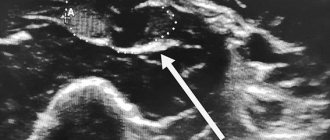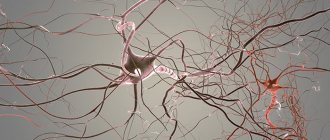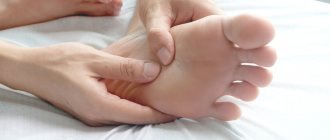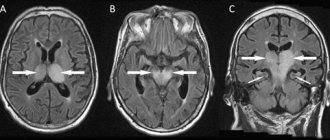Guillain-Barré syndrome is a severe autoimmune disease that affects the peripheral nervous system. The most common manifestation is acute tetraparesis, when movement of all four limbs becomes almost impossible. Other movements also cease, including swallowing, the ability to lift the eyelids, and spontaneous breathing. Despite this, the course of the disease is benign, most cases end in recovery. Transition to a chronic course or relapses are less common. Guillain-Barré syndrome occurs in all countries, regardless of their level of development, with the same frequency - approximately 2 cases per 100 thousand population, no dependence on gender. The disease can affect patients of all ages.
At CELT you can get advice from a neurologist.
- Initial consultation – 4,000
- Repeated consultation – 2,500
Make an appointment
Why does the syndrome occur?
The leading mechanism of development is autoimmune. In most cases, the onset of the disease occurs in the first three weeks after an acute respiratory or intestinal infection. Since a sufficient amount of time has passed since the moment of illness, and the symptoms characteristic of the infectious process have time to pass, the patients themselves, as a rule, do not associate these conditions with each other. The cause may be pathogens such as:
- Epstein-Barr virus or human herpes type 4;
- mycoplasma;
- Campylobacter, which causes infectious diarrhea;
- cytomegalovirus.
Researchers have found that the “sheath” of these pathogens is similar to the myelin sheath of the axon of peripheral nerves. This similarity causes the nerves to be attacked by antibodies, which are initially produced and circulate in the blood in response to the appearance of an infectious agent. This phenomenon is called “molecular mimicry” and explains why immune complexes attack the body’s own tissues.
Cases have been described when the syndrome occurs after vaccination, after surgery and abortion, hypothermia, and stress. In some cases, the cause cannot be found.
How it works
The nerve fiber itself does not transmit impulses very accurately and quickly, since the impulse has to spread along the surface of a long axon (up to a meter), constantly coming into contact with other fibers and losing charge.
Mother Nature pumped up our nerves to have a wire-like insulation called a “myelin sheath.” It is formed by the cells surrounding the neurons (by the way, there are 10-50 times more of them than the nerve cells themselves) by gliocytes, which with their bodies literally wrap the fiber in several layers, forming that same shell. It is not solid; for each axon there are many gliocytes, which envelop one section of the fiber (and neighboring fibers too), forming islands of myelin, between which there are junctions - nodes of Ranvier. Now the nerve impulse does not pass over the entire surface of the axon, but only along the bare surface: it seems to jump from interception to interception, which significantly increases speed and reduces losses.
If you take a twisted pair cable or USB cord and remove the insulation of the internal wiring, even in a small area, they will inevitably come into contact with each other and lose information. In the case of this syndrome, the myelin sheath is destroyed, exposing the nerve, which leads to disconnection and all the accompanying problems of signal loss. Fortunately, our internal nerve wires are able to repair themselves (although not always), so over time, damaged myelin islands are restored to new, albeit smaller ones - where there used to be one, 2-3-4 grow, which means there are joints between them becomes larger, and the speed of impulse conduction decreases forever, although this usually has no practical significance.
How does the syndrome manifest?
Over the course of several days, up to a maximum of 1 month, muscle weakness in the legs increases, and difficulties arise when walking. Next, the hands weaken, the last to suffer is the facial muscles. Such symptoms have a separate name - ascending Landry's paralysis.
But sometimes the paralysis begins from above, from the arms, spreading downwards, but all limbs are always affected.
Every fifth case is accompanied by paralysis of the trunk muscles, namely the diaphragm and intercostal muscles. With such paralysis, breathing becomes impossible and artificial ventilation is required.
A common manifestation is bulbar syndrome or bilateral paralysis of the muscles of the soft palate, when swallowing and clear speech are impossible.
Together with motor fibers, sensory fibers are sometimes affected. Sensory disturbances develop, tendon reflexes decrease, and pain in the limbs occurs. The pain is of a pronounced “neuropathic” nature - burning, a feeling of current passing, tingling. Pelvic disorders are rare, but most often there is urinary retention, which in some cases is combined with excess urine production.
Autonomic dysfunction is added, which is manifested by fluctuations in blood pressure, palpitations, other heart rhythm disturbances, sweating, and lack of intestinal motility.
Treatment of Guillain-Barré syndrome
After diagnosing this disease, the patient must be urgently hospitalized in a hospital, and in some cases, in intensive care. Sometimes, due to rapidly developing acute pulmonary failure, artificial ventilation of the lungs is required, since the respiratory system is damaged and without appropriate treatment and procedures the person may die. When the vital capacity of the lungs is 25-30%, the patient is recommended to undergo intubation or tracheotomy. This procedure will be necessary until the swallowing and cough reflexes improve. Disconnection from the device occurs gradually.
Diagnostic measures
Diagnosis is based on WHO recommendations. There are two leading diagnostic criteria:
- muscle weakness in the limbs that progresses;
- decreased or absent tendon reflexes from the first days of the disease.
WHO also identifies additional signs that confirm the diagnosis, which include:
- symmetry of the lesion;
- symptoms increase within no more than 4 weeks;
- sensory disturbances of the “gloves and socks” type;
- involvement of the cranial nerves, especially the facial nerve;
- possible spontaneous restoration of functions after stopping the progression of the disease (the so-called “plateau”);
- the presence of vegetative disorders;
- absence of hyperthermia (if there is fever, it is caused by other infections);
- an increase in the amount of protein in the cerebrospinal fluid, while its cellular composition does not change (protein-cell dissociation).
Definitive diagnosis is impossible without electroneuromyography or ENMG. This test reveals which part of the nerve is damaged - the myelin sheath or the axon. ENMG also accurately determines the extent of the lesion, its severity and the possibility of recovery.
Since, in addition to Guillain-Barré syndrome, there are a number of acute, subacute and chronic polyneuropathies, electroneuromyography allows for differential diagnosis between them and contributes to the development of correct treatment tactics.
Diagnosis often requires a lumbar puncture followed by a study of the cerebrospinal fluid, and tests such as:
- blood for autoantibodies to neuronal structures;
- blood for class A gammaglobulins (especially if immunoglobulin therapy is planned);
- biomarkers of neurofilament (part of the cytoplasm of a neuron);
- markers of tau protein (a special protein that destroys neurons).
Specialists at the CELT clinic additionally use their own differential diagnostic algorithms, which make it possible to reliably distinguish Guillain-Barré syndrome from other diseases that cause progressive muscle weakness in all extremities or tetraparesis.
Diagnostics
- Study of cerebrospinal fluid (protein-cell dissociation, from the 2nd week - a moderate increase in protein content).
- Serological blood tests for infections.
- ENMG (primary demyelinating lesion).
- Blood pressure monitoring, ECG, respiratory function testing.
Differential diagnosis:
- Polio.
- Other polyneuropathies (with diphtheria, porphyria).
- Transverse myelitis.
- Acute cerebrovascular accidents in the vertebrobasilar region.
- Myasthenia.
- Botulism.
Our doctors
Pankov Alexander Rostislavovich
Neurologist
40 years of experience
Make an appointment
Novikova Larisa Vaganovna
Neuropathologist, Candidate of Medical Sciences, doctor of the highest category
Experience 39 years
Make an appointment
Treatment rules
Today, two main pathogenetic methods of treating Guillain-Barré syndrome are known, and both are successfully used by CELT specialists. These are plasmapheresis and intravenous immunotherapy. These methods can be used in isolation or used in combination, it all depends on the specific clinical situation. Treatment is aimed at removing or neutralizing immune complexes circulating in the patient’s blood. Both treatment methods are equivalent and almost always lead to recovery. Treatment stops the process of destruction of peripheral nerves, shortens the recovery period, and helps reduce neurological deficits.
Plasmapheresis is a blood purification operation. Most often, hardware plasmapheresis is used on continuous separators, during which the blood taken from the body is divided into formed elements (or blood cells) and plasma (or serum). All toxic substances are in the plasma, so it is removed. The person is given back his own blood cells, diluted, if necessary, with plasma-substituting solutions or donor plasma. The duration of the procedure is about one and a half hours, the entire course consists of 3 or 5 sessions. No more than 50 ml/kg of plasma body weight is removed at a time.
During treatment, blood parameters are monitored: electrolytes, hematocrit, clotting time and others.
Intravenous immunotherapy is the administration of a human immunoglobulin class G drug. These immunoglobulins stop the production of antibodies to one’s own nerves, simultaneously reducing the production of substances that support inflammation. These drugs are indicated for the pathogenetic treatment of Guillain-Barré syndrome in both adults and children.
Simultaneously with specific treatment, careful patient care is provided, including the prevention of bedsores, pneumonia, and contractures. Treatment of concomitant infections is often required. Venous thrombosis is prevented, tube feeding is carried out, and excretory function is monitored. Bedridden patients undergo passive exercises, as well as early verticalization to avoid blood flow disorders. If there is a threat of developing contacture (immobility of joints), paraffin procedures are possible. If necessary, motor simulators based on biofeedback are used.
Patients with damage to myelin sheaths recover faster, while axonal damage requires a longer period of rehabilitation. Axonal lesions often leave behind neurological deficits that are difficult to correct.
Guillain-Barré syndrome is a disease in which the sheath of nerve fibers (myelin) is destroyed, which leads to impaired movement and sensitivity disorders. Usually develops some time after an infection.
Myelin is a special sheath of nerve fibers that is necessary for conducting nerve impulses. In Guillain-Barré syndrome, it is destroyed by the body's own immune system. Normally, the immune system detects and destroys foreign objects (for example, pathogens of infectious diseases), but in some cases it begins to fight native cells. As a result of damage to the myelin sheath, manifestations of the disease occur: decreased muscle strength, tingling in the limbs, etc. Most patients require hospitalization.
Timely treatment allows a complete recovery to be achieved, although some people may still experience muscle weakness and a feeling of numbness.
Synonyms Russian
Acute inflammatory demyelinating polyradiculoneuropathy, acute polyradiculitis.
English synonyms
Guillain-Barre syndrome, Acute Idiopathic Polyneuritis, Acute Inflammatory Demyelinating Polyradiculoneuropathy.
Symptoms
- Decreased muscle strength, tingling - first in the legs, then in the overlying parts of the body
- Intense pain in the shoulder girdle, back, hips
- Impaired chewing, swallowing, sound pronunciation, and facial expressions as a result of decreased strength of the muscles performing these functions
- Increased or slowed heart rate
- Increased or decreased blood pressure
- Respiratory disorders, the worsening of which may require artificial ventilation (carried out with a special apparatus when spontaneous breathing is ineffective)
- Urinary retention
- Constipation
General information about the disease
Guillain-Barré syndrome is a disease in which the myelin sheath of nerves is destroyed, resulting in impaired transmission of nerve impulses and decreased muscle strength.
The exact causes of the disease are unknown. In most cases, symptoms appear 1-3 weeks after an acute infection of the respiratory system or gastrointestinal infections.
These infections can be caused by these and other pathogens:
- Campylobacter - found in the meat of infected birds and causes a gastrointestinal infection when ingested by humans;
- influenza virus;
- Epstein-Barr virus (the causative agent of infectious mononucleosis);
- mycoplasma – can cause pneumonia in people infected with the immunodeficiency virus (HIV).
Vaccinations and surgical interventions can also be trigger factors for the development of the disease.
Autoimmune mechanisms also play an important role. The immune system fights foreign objects that enter the body. In response to infection, special protein particles called antibodies are produced. They detect and neutralize various infections and viruses. According to researchers, in Guillain-Barre syndrome, antibodies not only destroy infectious agents, but also damage the membrane of nerve cells, this is possible due to the similarity in the molecular structure of these objects.
The myelin sheath covers nerve fibers and ensures a certain speed of nerve impulses between the brain and various structures of the body. Disruption of the passage of nerve impulses to muscle fibers leads to a decrease in muscle strength. The nerve fibers of the autonomic nervous system (which regulates the activity of internal organs) are also affected. In this case, the functioning of the cardiovascular system may be disrupted, heart rhythm, blood pressure, etc. may change.
In severe forms of the disease, the following complications are possible.
- Breathing problems. It occurs as a result of weakness or paralysis (complete lack of ability to move) of the respiratory muscles and threatens the patient’s life. In cases where spontaneous breathing is ineffective, artificial ventilation of the lungs is performed (using a special device).
- Disturbances in the functioning of the cardiovascular system.
- Prolonged immobility. Increases the risk of thromboembolism (blockage of blood vessels with blood clots, leading to poor circulation).
- Bedsores are dead skin and underlying soft tissues that occur during prolonged immobility of patients due to impaired blood supply.
The disease develops over several weeks, and it may take several months to restore lost functions. In most cases, complete recovery occurs.
Who is at risk?
- Persons of young and old age.
- Patients with certain types of infectious diseases.
- Having undergone surgery.
Diagnostics
Diagnosis of Guillain-Barre syndrome is quite difficult, since there are no specific studies to identify it. In this case, diagnosis is based on an analysis of clinical manifestations, study of the history of the disease, and tests to exclude other diseases of the nervous system.
Laboratory diagnostics is of great importance.
- Total protein in liquor. Cerebrospinal fluid (CSF) bathes the brain and spinal cord. Various diseases of the nervous system cause certain changes in its composition. In Guillain–Barre syndrome, the level of protein in the cerebrospinal fluid increases.
To exclude other diseases, the following laboratory tests may be required:
- General blood analysis. Allows you to determine the number of formed elements in the blood: red blood cells, leukocytes, platelets. A decrease in the number of red blood cells and hemoglobin is possible with anemia, an increase in the level of leukocytes is possible with various inflammatory processes.
- Erythrocyte sedimentation rate (ESR). This indicator deviates from the norm in various diseases, in particular it increases during inflammatory processes in the body.
- Determination of vitamin B12 (cyanocobalamin) levels. If there is insufficient amount of vitamin B12 in the body, anemia and disturbances in the functioning of the nervous system may develop. Some symptoms of nervous system damage in B12 deficiency anemia are similar to those of Guillain–Barré syndrome.
- Detection of heavy metals in urine. The accumulation of heavy metals (for example, lead) in the body contributes to damage to the nervous system and the development of polyneuropathy (damage to various nerves).
Other studies:
- Electromyography. Allows you to record electrical impulses that travel along the nerves to the muscles. The conductivity of nerve fibers is assessed by their intensity; for this purpose, special electrodes are applied to the muscle being studied. The study is performed in a calm state and during muscle contraction.
Additional Research
- Magnetic resonance imaging (MRI). A diagnostic method based on the effect of a magnetic field on the human body. After processing the received signals, layer-by-layer images of the internal structures of the body are obtained. Allows you to exclude the presence of other diseases of the nervous system (for example, space-occupying formations).
Treatment
Treatment of the disease is conservative. Various drugs are used to eliminate individual manifestations of the disease and combat complications of Guillain-Barré syndrome.
The most effective methods are:
- Plasmapheresis. The patient's blood is taken, which is divided into a liquid part (plasma) and a part containing blood cells (erythrocytes, leukocytes, platelets). The blood cells are then returned to the person's body, and the liquid portion is removed. This achieves a kind of purification of the blood from antibodies that can destroy the myelin sheath of the nerves.
- Administration of immunoglobulin intravenously. Immunoglobulin contains antibodies from healthy blood donors. They block the destructive effect of the patient's antibodies on the nerve sheath.
It is very important to maintain impaired body functions (artificial ventilation), carefully care for the patient, and prevent complications associated with prolonged immobility of patients.
During the recovery period, physical therapy and physiotherapy are used to restore the strength of various muscle groups.
Prevention
There is no specific prevention for Guillain–Barre syndrome.
Recommended tests
- Total protein in liquor
- General blood analysis
- Erythrocyte sedimentation rate (ESR)
- Vitamin B12 (cyanocobalamin)
- Lead in urine
Literature
- Dan L. Longo, Dennis L. Kasper, J. Larry Jameson, Anthony S. Fauci, Harrison's principles of internal medicine (18th ed.). New York: McGraw-Hill Medical Publishing Division, 2011. Chapter 385. Guillain-Barré Syndrome.
- Corey Foster, Neville F. Mistry, Parvin F. Peddi, Shivak Sharma, The Washington Manual of Medical Therapeuticts (33rd ed.). Lippincott Williams & WilkinsPhiladelphia, 2010.23 Neurologic Disorders. Guillain-Barré Syndrome.
Prevention
The main method is the complete cure of infections that we consider banal and habitual. Guillain-Barré syndrome often develops with a slight weakening of the immune system, which is possible in every person.
The easiest way to protect yourself is to check your current immune status. This will only take a few days, and any abnormalities detected can be treated in time.
Doctors at the CELT clinic have at their disposal not only the latest diagnostic equipment, but also the latest treatment techniques that have received worldwide recognition. The main role in prevention belongs to the patient who seeks examination and treatment in a timely manner.
Make an appointment through the application or by calling +7 +7 We work every day:
- Monday—Friday: 8.00—20.00
- Saturday: 8.00–18.00
- Sunday is a day off
The nearest metro and MCC stations to the clinic:
- Highway of Enthusiasts or Perovo
- Partisan
- Enthusiast Highway
Driving directions
general description
Guillain-Barré syndrome (acute inflammatory demyelinating polyradiculoneuropathy) (G61.0) is an acutely developing autoimmune inflammatory disease of the peripheral nervous system, characterized by acute demyelination of the roots of the spinal and cranial nerves, clinically manifested by paresthesias of the limbs, muscle weakness and/or flaccid paralysis.
Prevalence of the disease: 1–1.9 per 100 thousand people. The onset of the disease is observed at the age of 30–50 years.
The causes of the disease are unknown, so the syndrome is otherwise called idiopathic polyneuropathy. Immune-mediated factors play a role in the development of the disease. 2 weeks before the onset of symptoms of the disease, most patients notice symptoms of a respiratory or gastrointestinal infection.









